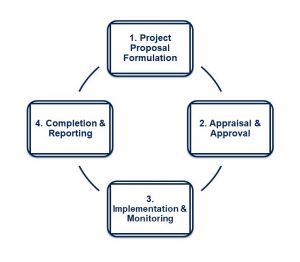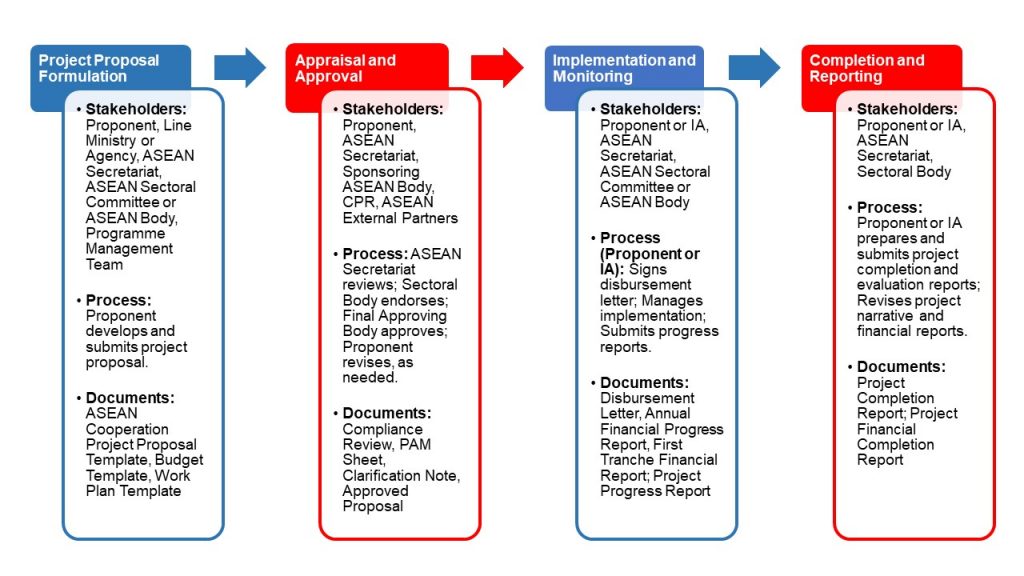Overview
ASEAN Cooperation Project is one of the means to facilitate ASEAN’s integration and community building process. It contributes to the overall ASEAN Community Vision 2025, a roadmap that comprises blueprints for the three ASEAN Community Pillars—the ASEAN Political-Security Community (APSC), the ASEAN Economic Community (AEC) and the ASEAN Socio-Cultural Community (ASCC)—and includes the the Initiative for ASEAN Integration (IAI) Work Plan IV and the Master Plan on ASEAN Connectivity (MPAC) 2025.
 ASEAN Cooperation Project adheres to the principles of the ASEAN Charter, including the principles of ASEAN centrality and equality of treatment of ASEAN Member States. It benefits and engages all ASEAN Member States. It also involves cooperation with ASEAN External Partners as guided by cooperative partnerships. To know more about ASEAN External Partners and the documents guiding their cooperative partnerships with ASEAN, click here.
ASEAN Cooperation Project adheres to the principles of the ASEAN Charter, including the principles of ASEAN centrality and equality of treatment of ASEAN Member States. It benefits and engages all ASEAN Member States. It also involves cooperation with ASEAN External Partners as guided by cooperative partnerships. To know more about ASEAN External Partners and the documents guiding their cooperative partnerships with ASEAN, click here.
ASEAN Cooperation Project addresses challenges at the regional level and creates synergies with other initiatives that address the same issues. It can be implemented over the short, medium, or long term.
 ASEAN Cooperation Project is supported by various funding sources. ASEAN maintains the ASEAN Development Fund (ADF), ASEAN Cultural Fund (ACF), and a number of ASEAN sectoral funds, which are supported by ASEAN Member States to advance ASEAN sectoral priorities. ASEAN External Partners also set funds to support development cooperation with ASEAN. To know more about the available funding mechanisms and modalities for ASEAN Cooperation Projects, click here
ASEAN Cooperation Project is supported by various funding sources. ASEAN maintains the ASEAN Development Fund (ADF), ASEAN Cultural Fund (ACF), and a number of ASEAN sectoral funds, which are supported by ASEAN Member States to advance ASEAN sectoral priorities. ASEAN External Partners also set funds to support development cooperation with ASEAN. To know more about the available funding mechanisms and modalities for ASEAN Cooperation Projects, click here
 ASEAN Cooperation Project is conceptualised, developed, and implemented as guided by the ASEAN Project Management Framework (PMF). The ASEAN PMF follows a cyclical approach and aligns with the principles and approaches of results-based management. The ASEAN Cooperation Project cycle comprises four stages: project proposal formulation, appraisal and approval, implementation and monitoring, and completion and reporting. To know more about the ASEAN Cooperation Project Cycle, click here.
ASEAN Cooperation Project is conceptualised, developed, and implemented as guided by the ASEAN Project Management Framework (PMF). The ASEAN PMF follows a cyclical approach and aligns with the principles and approaches of results-based management. The ASEAN Cooperation Project cycle comprises four stages: project proposal formulation, appraisal and approval, implementation and monitoring, and completion and reporting. To know more about the ASEAN Cooperation Project Cycle, click here.
ASEAN Cooperation Project is supported by various funding sources. ASEAN Member States dedicate specific funds, including a number of ASEAN sectoral funds, to advance ASEAN priorities. Similarly, ASEAN External Partners also set funds to support development cooperation with ASEAN. In general, there are three types of Funds, classified and described as follows:
Type of Fund | Description |
| ASEAN Funds |
|
| ASEAN Partners’ Trust Funds | Provided by ASEAN External Partners (Dialogue and Sectoral Dialogue Partners) and managed by the ASEAN Secretariat |
| ASEAN Partners’ Funds | Provided by ASEAN External Partners (Dialogue, Sectoral Dialogue, and Development Partners as well as International Organizations) and NOT managed by the ASEAN Secretariat |
Table 1. ASEAN Cooperation Project Funding Mechanisms
For the ASEAN Funds and ASEAN Partners’ Trust Funds, the main Terms of Reference (TOR) and Rules of Procedures (ROP) are explained as below:
Cooperation Framework | TOR and ROP (as approved by ASEAN and its External Partner) |
| Funding Contribution | External Partner deposits to ASEAN Secretariat annual/regular contributions |
| Source of Projects | Projects can be initiated by the 10 ASEAN Member States and External Partner, based on agreed priorities |
| Fund Disbursement/ Management | Fund is disbursed by the ASEAN Secretariat to the Implementing Agency of the approved project |
| Application of ASEAN Project Management Framework (PMF) | Guidelines and procedures of the ASEAN PMF are fully applied. |
Table 2. ASEAN Funds and ASEAN Partners’ Trust Funds
For ASEAN Partners’ Funds, the main procedures are explained as below:
Cooperation Framework | Programme Document (jointly developed by ASEAN and its External Partner and approved based on ASEAN procedures) |
| Funding Contribution | External Partner allocates and manages the fund |
| Source of Projects | Single project proposals or activities defined by the programme document /annual work plan |
| Fund Disbursement/ Management | External Partner manages the funds and, in some cases, contracts Technical Assistance Team (TAT) to implement the programme. The TAT reports to a Steering Committee composed of ASEAN and External Partner. |
| Application of ASEAN Project Management Framework (PMF) | Only main elements of the guidelines and procedures of the ASEAN PMF are applied. |
Table 3. ASEAN Partners’ Funds
In general, table below describes the predominant modalities of ASEAN External Partners:
TYPE OF EXTERNAL PARTNER | PROJECT-BASED | PROGRAMME-BASED |
| Dialogue Partner | Canada, China, India, Japan, New Zealand, Republic of Korea, Russia, UK | Australia, European Union, United States |
| Regional Cooperation Mechanism | ASEAN Plus Three (APT) | |
| Sectoral Dialogue Partner | Norway, Pakistan, Switzerland, Turkiye | |
| Development Partner | Italy, France | Chile, Germany |
| International Organization | United Nations and its Agencies, World Bank, ADB, Others |
Table 4. Modality of External Partners’ Cooperation with ASEAN
To know more about the details of the various funding mechanisms and modalities for ASEAN Cooperation Projects, click here.
ASEAN Cooperation Project is conceptualised, developed, and implemented as guided by the ASEAN Project Management Framework (PMF). The ASEAN PMF follows a cyclical approach and aligns with the principles and approaches of results-based management. The ASEAN Cooperation Project cycle comprises four stages: project formulation, appraisal and approval, implementation and monitoring, and completion and reporting.

Figure 1. The ASEAN Cooperation Project Cycle at a Glance
- Project Proposal Formulation
Project proposals are developed using the ASEAN Cooperation Project Proposal Template and designed following the principles and approaches of results-based management. The project’s objectives and intended results must be aligned with key ASEAN policy documents, such as the ASEAN 2025: Forging Ahead Together roadmap, Initiative of ASEAN Integration (IAI) Work Plan IV (2021-2025), and the Master Plan on ASEAN Connectivity (MPAC) 2025 and relevant ASEAN sectoral work plans. Project proposals must clearly indicate how a project intends to achieve its intended results, rather than simply list a set of project activities.
- Appraisal and Approval
The ASEAN Secretariat appraises project proposals to ensure compliance to the ASEAN Cooperation Project Proposal Template before forwarding to the ASEAN Sponsoring Body for endorsement, or to the Final Approving Body. A project proposal is appraised based on its relevance to ASEAN priorities. The ASEAN Secretariat also determines how effectively and efficiently a project proposal can realise its intended results, based on context and timeframes.
- Implementation and Monitoring
After appraisal and approval, a project begins implementation. Proponents or Implementing Agencies (IA) must monitor and report on the progress of the project against its approved monitoring and evaluation and work plans. The project monitors progress against its intended results—performance indicators and corresponding targets—and conducts evaluation, as applicable. A Progress Report Template is provided to guide the reporting requirements, including relevant guidance for monitoring and evaluation activities.
- Completion and Reporting
At the end of implementation and in relation to the project’s monitoring and evaluation, the Proponent or IA must prepare a Project Completion Report on the project’s results and achievements, based on data collected when monitoring project implementation as well as on additional evaluation findings, if any. Whether intended or unintended, all results must be assessed to draw lessons learned on sustainability, funds utilization, guidance for future projects, among others.
To know more about the details of each step, including related guidance to stakeholders on the procedures and required templates, see the ASEAN Cooperation Projects Design and Management Manual.
- List of ASEAN Cooperation Projects
- List of ASEAN Cooperation Programmes




